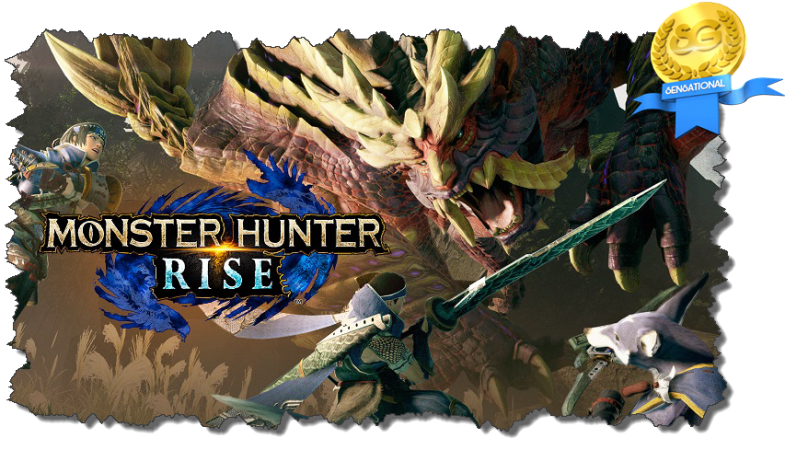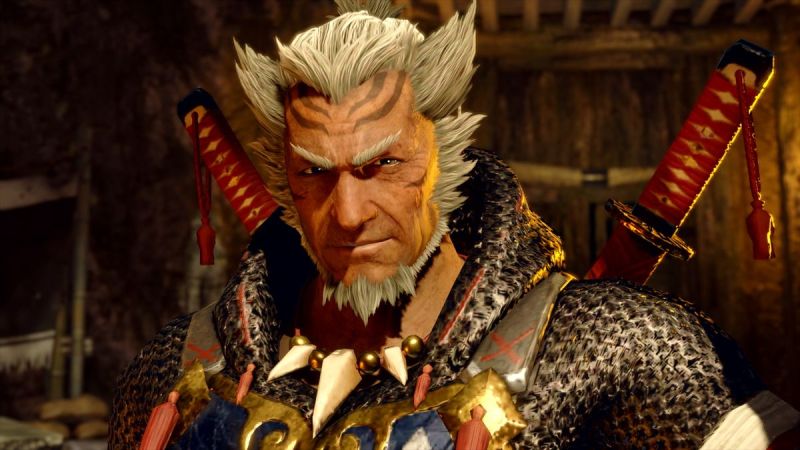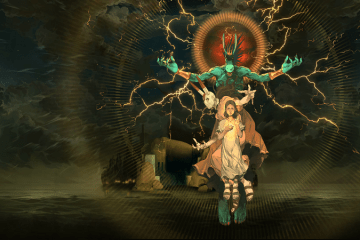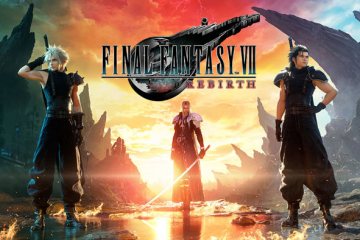
You can find Seasoned Gaming’s review policy here
Monster Hunter. At the sound of those two words, many gamers instantly get excited. But some hear them and are filled with dread or disgust. Still others are between these extremes, and I’m willing to bet that there are quite a few gamers that couldn’t pick a Monster Hunter out of a lineup. How could this be, given the breakout success of Monster Hunter World, Capcom’s best-selling game of all time? There were some pitfalls that still kept many gamers at bay from trying the franchise out, and several shock traps still exist that may send wary gamers away before even trying Monster Hunter Rise. In spite of its hurdles, Monster Hunter World was on to something with its streamlining of features and game systems, and fans wanted to know where the franchise would go with the newly rooted foundation. So, how does the newest entry, Monster Hunter Rise, fare alongside its elder siblings? Ready your charge blade and don your Somnacanth gear as we join the hunt to discover how high this edition rises.
The first thing I must do is present a disclaimer. Everyone here at Seasoned Gaming knows my love for the Monster Hunter franchise, and now you do as well. So, I’m naturally going to brand a 10 to the front of this one and send it on its way, yes? Well, not so fast. We at Seasoned Gaming are seasoned enough to not allow biases to get in the way of our reviews. Mostly. Monster Hunter Rise isn’t a perfect game, but it is a Palamute ride forward in terms of accessibility in the franchise, even in the face of Nintendo’s hindering online service. But what about those that have no idea what any of these crazy references mean? I’m glad you asked, and to find all of the answers, let’s start from the outside and work our way in.

Monster Hunter is a franchise of games where you play as a titular hunter of monsters, and each game has some slight semblance of a story to keep you out hunting in its many maps, battling monsters of various categories and styles. You choose one of several weapons, each completely different from the last. Whether you choose the slow, methodical great swords; the lightning-quick dual blades; the 3rd-person shooter feel of the light bowguns; or any of the other incredibly diverse weapon choices, you’re bound for an experience that few games can match. That is, provided you can outlast the slog of the slow beginning hours.
The series has been notorious for being hard to get into due to an insane amount of depth, some welcome and some otherwise, slow tutorial quests, and a vaulted ceiling of a learning curve. Others state that the control scheme is slow and sluggish, and while a slow and deliberate style certainly exists for some of the game’s 14 different weapons, it does not hold true for all of them, especially in the modern games. Still, though these barriers to entry have existed since the first game, the Monster Hunter team has worked to bring in more accessibility.
When Monster Hunter World released in 2017, the game had finally shed many of its barriers, streamlining many of the systems that were not needed or that were overly obtuse. With Monster Hunter Rise, the streamlining efforts went even further. Returning are open maps with no loads, whetstones and harvesting equipment that is unbreakable without taking up slots in the inventory, and the shortcut menu that allows you to use your many pieces of equipment without needing to scroll through your options (though that method is still available as well). After playing World, even the most devout of “old-school” monster hunters agreed that these were welcome changes, but Rise rose to the next level.

The commitment to streamlining the many systems in Monster Hunter went on overdrive for Monster Hunter Rise. Hunters now need only to take a single action to produce all available harvest from a location. Just one swing of the pickaxe will net you every stone in the node, and this is true for all other harvest locations with the exception of the monsters themselves. The “pure” monster carving was clearly done as a balance, asking the hunter to weigh the risks of carving materials from a slain monster while a mammoth made of teeth menacingly watches on. Also, tracking these monsters now takes no effort since the locations of all major monsters in an area are clearly and always displayed on the mini-map, provided by your new “Cohoot,” an owl that auto-tracks everything in the map. This keeps the focus on why we play Monster Hunter games in the first place: combatting these terrifying beasts of mayhem.
Speaking of the areas, each map is interesting and completely different from the next. They feel more like a return to the older Monster Hunter games, with some nods to the World maps. There are still no loading screens, which was a very welcome change in Monster Hunter World, but each area has a layout that feels like the older maps, meaning a bit smaller than the World maps with more areas that feel like arenas instead of twisting and winding paths. They feel like a happy hybrid of the two map styles, and they are incredibly fun to explore and play in.
Hybrid is a fitting term to use with Rise. It takes many of the things that helped World shake the monster hunting world (pun intended) and blends it with the styles of previous games, helping Rise to distill the pure gameplay to the parts players want to play. The early quests in Rise get you right on the hunt, having only a couple quests that have anything other than hunting monsters as their goal. The hub has been compartmentalized to only a few sections with only a few main NPCs needing to be dealt with. Instead of having to talk with the optional subquest giver and then go to a different location for main quests, they are now all given by the same person. Right next to this person is your equipment box with virtually the same functionality as found in World, complete with auto-crafting options for every craftable item. Right across the street from the quest giver is the blacksmith, where you will likely spend an obscene amount of time purchasing and upgrading weapons and armor. Next to the blacksmith is the palico and palamute item handler who utilizes a new scrap system, taking the scraps from smithed items so your trusty followers can more efficiently remain decked out in the latest threads.

Everything is streamlined, but that doesn’t mean there is nothing new. Apart from the aforementioned scrap system, you now have a palamute as well as a palico. While palicos (cat-like followers) continue to utilize many tools to assist with your hunts, palamutes (dog-like followers) help you attack, and allow you to ride them to carry you very swiftly around the maps, even running up walls, without expending your stamina. Hunters are also given access to something called the wirebug. It functions like a Spider-Man web, flinging you forward or upward at great speeds. To balance this great power, each use costs one of your two bugs, which is then put on a brief cooldown before you may use it again. You may also find an additional wirebug around each map, giving you 3 bugs for a limited amount of time. Each weapon can utilize these bugs as well for unique moves, called silkbind moves, that can put a monster into a state of rideablility.
The living monstrosities in the Monster Hunter games have been mountable since Monster Hunter 4, but Rise completely changes how this works. Gone is the mounting mini-game, and in its place is a riding mechanic that is so completely awesome that this reviewer thinks the game should have been called “Monster Hunter Ride.” When you saddle up on one of these enormous ponies, your control scheme changes. You are given a timer that can be elongated or decreased based on your actions atop the beast. If there is another monster around, and it is usually a good bet there will be, then you can live out your Godzilla vs. King Kong fantasies, or, rather, Anjanath vs. Bishaten fantasies, or the like. You get access to 2 of each monster’s moves, and a 3rd finisher of sorts once you’ve built up a special meter during your battle. You may also simply ram the creature’s head into a boulder, tree, or mountain a few times until you come to an understanding. I cannot stress how much this changes the game, and how much fun this dynamic adds.
All of this monster hunting excitement must follow some structure, and in Rise the motivation for your hunts is based on rampages that have been running rampant. These rampages consist of giant groups of monsters that must be stopped, and your quests vaguely relate, somehow. As you progress, you will encounter special Rampage Quests, which are a tower defense mini-game. Depending on the quest, you will have access to several locations where you must place different types of defenses, some automated and some needing your control, to quell the monster hordes. These are interesting distractions, but they lack the depth found in full-fledged tower defense experiences. As such, the quests are fun, but I suspect not many will be spending much time with these as opposed to the hunting goodness that the main quests provide.

And what a treat the monster hunting is! Each weapon has been even further balanced from past games, and the additions of silkbind moves and wirebug traversal means you have even more entry points, escapes, and options in your battles. The map design has some truly epic locations that will forever burn into your retina and brain as you go to absolute war with these enigmas of evil. The insane amount of abilities, builds, and loadout options marry perfectly with the additional tactics brought about by your palico and palamute. The visceral feel of each swing landing is always satisfying, and the evidence of your engagement is plain and easy to see as the beasts scar up, salivate, and writhe brilliantly from your actions. Figuring out strategies to counter the move sets and weaknesses of each of the many, unique monsters on offer is tantamount to your experience and success. When you topple one of these debonair devils, especially the tougher ones encountered as you progress, there is a sense of accomplishment on the same level as you would find with the demise of a Souls-type boss. It all adds up to some of the most fun you will have yet in a Monster Hunter game.
The action is smooth and beautiful, too, even at 30 frames per second. Utilizing the versatile RE Engine, Monster Hunter Rise is a very good-looking game. While the Switch simply does not have the power found in other current systems, the stylized graphics do a lot to deter this. Undocked, the game looks vibrant and stunning, though in docked mode you will notice more of the jaggies, alongside a strange sort of yarn-looking filter that occurs when viewing the characters at certain angles. Regardless, the shear amount of effects shimmering off of the weapons and monsters always impresses. The humming glow of the hunter’s armor when certain effects have activated, the rain of sparks flying after deflections, the ambient artifacts giving life to the wonderfully-designed maps; everything the game does to glue your eyes to the beauty on the screen at any given time is astonishing. The limitations of the Switch hardware certainly hold the game back visually, but not to the extent that I was expecting. Although it is not as glorious as games found on better hardware, it is still a feast for the eyes, and it constantly had me marvelling at what they were able to pull off.

Moving to the sound, things are a bit more hit and miss. The soundtrack is typical Monster Hunter fare, but that basically means any given musical track can be anywhere from lovely to horribly annoying. The game opens with a beautiful song, along with a woman singing. The singing is pervasive throughout the town, and overall I did like the town’s music. Ordering a meal, which gives you temporary perks for your hunt based on your selection of 3 different “dango” foods chosen, is accompanied by some of the most brain-numbingly annoying music I have ever suffered through. It is so bad that I thought it must be part of some world takeover scheme by Capcom, though my ears were bleeding too much to figure out how, or why. Mercifully, you are able to skip the cutscenes that attack you with these weaponized tunes. I was ever happy to discover this, and if there is anything you take away from this review, let it be that you skip those horrid scenes, saving your family and yourself from the emotional trauma they undoubtedly have caused many others. When on your hunts, the music is pretty decent, though there likely are not many songs here you will find yourself humming along to.
The sound effects do a mighty job, however. Every elemental effect has a satisfying sound, and every effect sounds exactly as it should. Those coming from previous Monster Hunter games will feel right at home with the effects, most of them sounding just as you remember them. One thing that has been touched up is the impactful sound of your weapon smashing, slamming, slicing, and skewering the monsters. Everything is even punchier-sounding than before, and it is very welcome, along with the overall sound design.
Controlling all of the action feels just as it should. Taking the progress found in World, Rise refined those controls and balanced it all for the implementation of the wirebug functionality. Each weapon feels like the silkbind moves belong, and each weapon now has even more depth because of it. Controls are very responsive, and even though the controls for each weapon vary wildly from the next, they soon become second nature within minutes.
One caveat I must mention: with the modern conventions taken in World for the shooting controls of the bowguns and some other weapons, hunting monsters felt right at home on the Xbox and Playstation controllers. Although Rise released on the Switch, these conventions remained. While not necessarily a bad thing, the Switch’s Joy Cons can make the aiming feel less precise if you are used to the other controllers. As such, I strongly recommend a Pro controller or an equivalent to it. The game will feel much better, and you’ll spend your time fighting the monsters instead of the controls.

Something else I want to stress for new players: every weapon type feels absolutely different from the next, to the point where it can feel like you are playing an entirely different game depending on which you choose. Because of this, it is possible to pick a weapon that you absolutely despise, but then try another one and completely fall in love with the style of play afforded by it. For those new to the series, I highly recommend Dual Blades, Long Sword, or Sword and Shield. This does not mean these are mere “beginner” weapons which should be moved on from when you get better. Each weapon has a ton of depth, but these will feel more like other action games, and newer players will likely feel more natural with them instead of frustrated when trying to figure out the quirks in the other weapons. Other recommendations for newer players would be the Light Bowgun, effectively turning the game into a shooter, or the Great Sword for more of a Souls-type feel. If you are feeling even more adventurous, I highly recommend taking whichever weapon you pick into the training area and watching an online guide to discover all of the nuances and depth packed into whichever implement of destruction you have decided to bring to a monster fight.
Not only will you be fighting monsters, but you will be harvesting anything and everything you come across because you need materials, both from monsters and the environment, to forge better weapons and armor. This allows you to fight even stronger monsters and access rarer materials, which you can use to forge even better equipment. This loop is phenomenally addicting, and the feel of “just one more monster” will propel your hours played to new heights. There is always something to do, and there is nothing wasted.
More than any other game ever made, I want to hammer that point home about this one: there is absolutely nothing that goes to waste. In many games, there will come a point where money becomes basically pointless, or you will loot all sorts of “junk” you will never use because what you have is better. In Monster Hunter, this never happens. No matter what you loot, and regardless of how much currency you have, there is always some way to use it. Say you harvest a ton of Kulu-Ya-Ku plumes, but you don’t need any of the weapons or armor those can lead to. Every item has an intrinsic value assigned it, and there is a melding pot where you can throw in unwanted items and get something you actually can use. This requires currency as well as materials, and the rarest items can cost countless arms and legs. Since all items can be used to get others, there is no waste, and everything you acquire is seen as a means to something that you actually will want. I wish more games did this, but having it utilized in Rise has been welcome as I climb the ever-rising totem pole to the ultimate hunter of monsters.
There are so many things Rise does well like this. Not only does it continue the “no waste” tradition, but there is always something to do. Well after the credits roll (which veteran monster hunters realize is never really the end), the game introduces many more monsters to face off against. In World, the weapon cosmetics were bland and “samey” from one to the next, but Rise fixes this issue as well. It also has unparalleled depth. The arena events and quests, the palico and palamute training, the online hub area complete with tailored quests and challenges for a full group of four hunters, the endless combination of strategies and tactics to discover among all of the weapons and equipment against every unique and interesting monster, it all presents a package that will keep you playing for countless hours into the wee hours of many mornings.

However, there are some issues and pitfalls that can snare the experience. First, though there is plenty of game to play, the “end game” that has been typical for Monster Hunter releases is non-existent at the moment. Capcom has promised to continue support for the game, and they have quite a track record in doing so with the other Monster Hunter games. For the moment, however, the experience may feel somewhat anemic at the end. Also, there is currently no support for voice communications when playing in multiplayer. This is actually common territory for the Monster Hunter series. Though World allowed for voice communication, every other Monster Hunter game features no voice chat function, including Rise. The game has a lot of creative ways to communicate with others, and it is something monster hunters have been accustomed to for some time, but it is still a bummer to exclude a feature that so many are used to relying on, especially when the online is so much fun in Rise. Finally, let us not forget the dreadful canteen tunes which I am surprised have not cracked every cartridge on which they were included.
Even with its hiccups, I highly recommend Monster Hunter Rise to absolutely all gamers. Its maps beg to be explored. Its monsters, big and small, are versatile, unique, and infinitely rewarding to engage in battle. Its locations are memorable and varied. With every hunt, you will find monsters, and far more. You will find adventure atop and below every amazingly-vertical and detailed map. You will be charmed by the many townsfolk and the denizens of areas you will traverse. You will yell in disgust as your opponent gets the better of you, and you will erupt in excitement when you finally triumph over the beast. Alone, or with your friends, you will not forget the epic hunts that await. They will become a part of you, and you of them. If you are even remotely interested in having a fun, engaging experience, dust off your Switch and prepare yourself. Monster Hunter Rise is an adventure that will sink its fangs in deep and not soon let go.



[…] Review : Monster Hunter Rise : Rise From Your Glaive […]